Fave Fresche etc. (Fresh Favas)
Fave Fresche etc. (Fresh Favas)
-
-
-
-
-
Fave Fresche etc. (Fresh Favas)
-
Post #1 - May 13th, 2005, 9:09 amFave:
cacio e baccelli, pasta con le fave fresche,
e il "macco magnificato"
In a thread initiated by Ann Fisher about a year ago titled “Things to Eat Only in Season” (link) , I offered a list of some of my favourite things which fit into that category but, presumably on account of an attack of nostalgia for Belgium I may then have been suffering, I focussed primarily on the seasonal produce I enjoyed over my years living in that spatially tiny but gastronomically grand little land. This post is in a sense an addendum to the short paragraph on things Italian I tacked on at the end of that piece.
***
A few months back I posted on what I regard as some of the Peccati Culinarii: Over- and Misused Ingredients in Italianoid Cooking (link). As the thread developed, focus shifted briefly from the over- and misused in American takes on Italian food to some of the items that are in Italy basic elements of the cuisine(s) but are realtively little used and very much underappreciated on this side of the ocean. In this regard, I wrote the following (link):
Antonius wrote:Beans and greens are real staples all through the south but they are also eaten often and prepared with great elegance throughout the north as well. I think I remarked in an acrimonious thread on Italianoid chains about how striking it is to me that [such chains (e.g., Olive Garden, Romano’s Macaroni Grill, Buco di Beppo)] typically offer no dishes which feature beans of any sort (at most, perhaps a minestrone with a couple of beans floating around) and that is downright bizarre to my mind. Fave, ceci, cannelini, borlotti, lenticchie and many others are used as the basis of soups, salads, pasta dishes, as side dishes to meat and fish preparations and even as snacks. Italian cuisine without beans is like American cuisine without beef.
I love virtually all kinds of beans and cook them with great regularity and frequency and for me, as for many others who grew up in an Italian family, pasta e fagioli or, in Neapolitan dialect, pasta e fasulë is as near as anything gets to what I constantly hear people refer to as “comfort food,” though I’ve always thought of it more as “soul food.” A simple and noble dish.
And yet, as basic and thoroughly and genuinely and authentically Italian as pasta e fagioli has become to those regions which have developed and embraced their own version, there are bean dishes which somehow belong to a deeper, more Italian level of the cuisine. Here I refer to the dishes made with the Old World beans, the legumes that have been consumed by all levels of Italian society since before the introduction of the exotic foodstuffs from the New World, since before even the days of the Roman Empire: lentils, chick peas and broad beans –– lenticchie, ceci e fave.
***
Among the many points of similarity between Mexican and Southern Italian food habits is an affection for favas. Indeed, during Lent, many Mexican restaurants offer seasonal specialities involving favas, including soup made from the dried and split favas. And soon after the end of Lent, all of the better Mexican grocery stores in Chicago start to carry fresh favas, one of the seasonal treats of spring. Over the past several weeks, I have availed myself of the fresh favas to be got at a nearby Mexican grocery, El Güero (Cermak by Damen), and have been revelling in the opportunity to make some traditional Southern Italian dishes.
The first batch I got was not especially large and, after the smallest, most tender ones were consumed during the peeling process, the remaining quantity was such that they needed to be stretched a bit. Consequently, I made a soup with onion, pancetta, brown lentils, acini di pepe and the fresh favas which functioned more as a garnish:
The second batch was a bit larger, and the pods and beans too were generally a little bigger; here are the whole pods: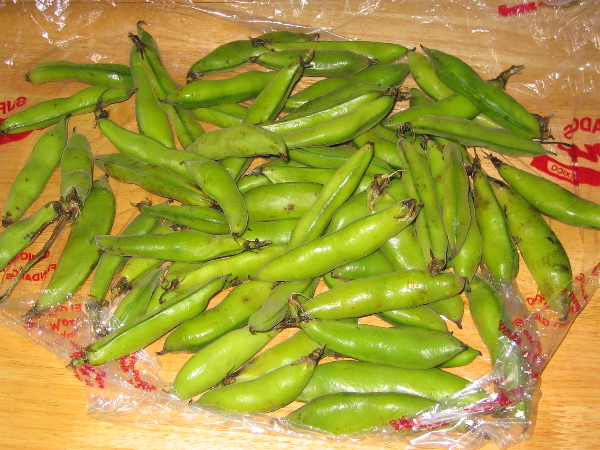
Although the pods and beans were bigger, there was still a very high percentage of the beans which were small, bright green and tender and even some of the larger ones were still very green and very tender. These raw beans are eaten as a snack by Italians; I like to dip mine in olive oil that has had a little salt and pepper added and eat some or most of them with a little piece of pecorino, as shown below. Note that the one bean off the plate in the foreground has (obviously) been gotten out of the pod already but has not yet been peeled, thus bearing still the brown 'eye':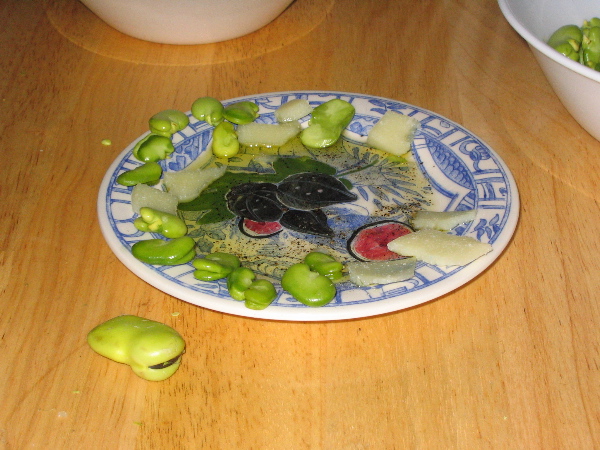
Fresh little favas and pecorino are such a popular combination and -- to Italians at least -- go together so well that in Italian the proverbial expression "cacio e baccelli" is used to refer to any two things that are exceedingly well matched to oneanother.
As Amata admonishes me for giving Lucantonius an especially sharp knife with which to carry out his k.p. duties, the young lad surprises all by jocularly interjecting an old Neapolitan expression -- A che gghiuóco jucammö?, that is, "What game are we playing?":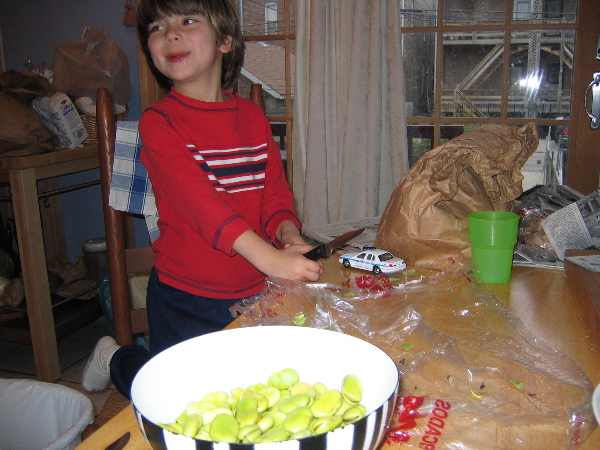
On this occasion, there were enough favas that, despite the immediate consumption of so many baccelli raw with pecorino, there remained enough to make a dish which included favas as a main ingredient. This time I made pasta con le fave fresche, a dish which from Rome to Sicily shows relatively little variation in its basic character. The traditional ingredients are almost everywhere across this large area simply a cured pork product (prosciutto or pancetta) and onions (browned slightly in olive oil); some water is added in which to cook briefly the fresh favas. Ditali is an especially appropriate shape of pasta for this sort of dish and one can make the final product more or less soupy with the cooking liquid from the pasta. Finishing at table should be limited to doses –– to my taste, large doses -- of freshly ground black pepper and freshly grated pecorino. In Agrigento, a little fresh ricotta is added and that's not at all a bad thing to do. Here's my bowl of pasta con le fave fresche, accompanied by a couple of slices of the outstanding whole wheat bread from the Masi's Italian Superior Bakery (link):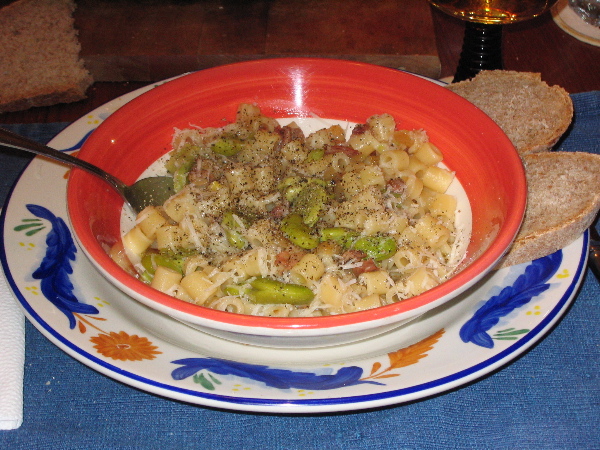
Another large batch of fresh favas was purchased this past weekend and I had an idea to make a dish of my own invention which came to me with the somewhat Chinese sounding name of "fava beans cooked two ways." In effect, the dish is a cross of the traditional way to make fresh favas (with onion and prosciutto or pancetta) and one of the traditional ways to make the very ancient Southern Italian dish macco, a puree made from cooking for a long time the dried and peeled and split fava beans. My source for these dried favas, in Italian fave sgusciate, is Graziano's on Randolph (link), where they can be had in bulk at the delightfully low price of $1.65 per pound.
In the following picture are displayed most of the primary ingredients for our meal the other day. At the far left is a bunch of porcellana or, in Spanish, verdolagas, that is, 'purslane', which we ate as a contorno alongside our macco magnificato. In front of the greens is a large piece of sharp pecorino from Sicily, 'ncanistratu (also purchased at Graziano's), and to the right of the cheese and greens are: 1) a plastic bag filled with the uncooked dried fave sgusciate; 2) a pot filled with the dried favas which have been cooked to a paste; 3) the fresh peeled favas. To the right of the fresh beans in the foreground is a large hunk of prosciutto di parma and further back to the right is a bag of Divella pasta (vermicelli broken up for use in soup) and a bottle of Mantova olive oil, an oil from the same area (Provincia di Frosinone) whence hails part of my family.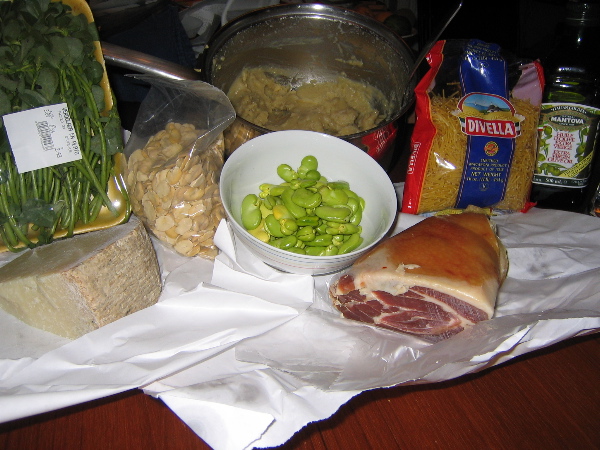
Whereas fresh favas tend to be cooked in Southern Italy with onion and prosciutto or pancetta, recipes with dried favas there tend more often to have garlic instead of onion and often to have a touch of tomato. For my "macco magnificato" I used a little onion, small cubes of prosciutto, a little garlic, and a few San Marzano pomodori pelati as the base, to which were subsequently added some water, the fresh favas, the macco puree, the cooked pasta, and at the end a sprinkle of minced parsley, a dusting of black pepper and a drizzle of olive oil. It was, if I do say so myself, quite delicious. Ecco questo bel piatto mio: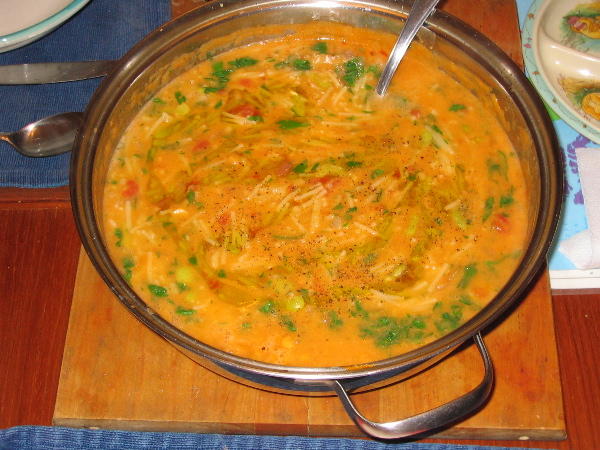
I had hoped to get this post out sooner, while there was more left to the season of fresh favas. But there should still be good ones available. If you haven't ever tried them, do so. The tender fresh small baccelli are a real delight raw and cooked up in soup or with pasta they're also wonderful. Preparing them entails a good bit of work but if the work is done by the whole family, perhaps with a glass of wine on the side, it's time very well spent.
AntoniusAlle Nerven exzitiert von dem gewürzten Wein -- Anwandlung von Todesahndungen -- Doppeltgänger --
- aus dem Tagebuch E.T.A. Hoffmanns, 6. Januar 1804.
________
Na sir is na seachain an cath.
-
-
Post #2 - May 13th, 2005, 9:22 amThe stains and smells on the hands after peeling fave are unmistakable and part of the whole experience.
Something that pairs well with fave, if you're in a place where they hit the market simultaneously, is asparagus. I once made a very simple ragout of asparagus and fave cooked in butter and served over fresh homemade pasta, it was a springtime delight.
-
-
Post #3 - May 13th, 2005, 9:34 amA,
As always, a magnificently informative post.
The dish that appeals most to my lazy arse is the fresh fava, olive oil and pecorino snack. It looks so fresh…and simple. I’m hoping they sell fava at Maxwell Street Market, as I plan to drop by again this weekend.
I’m not sure if you’ve addressed this issue elsewhere, but why is it that canned fava (like those bearing the Progresso label) are brown? My assumption would be that the cooking process accounts, in part, for the color change, or perhaps they are a different breed of bean.
Hammond
PS. Incidentally, I’m meeting a client at Club Lago for Chicken Vesuvio later today – it’s not regularly on the menu, but I called ahead; will report if of note."Don't you ever underestimate the power of a female." Bootsy Collins
-
-
Post #4 - May 13th, 2005, 9:46 amGreat post Antonius, but I wonder one thing. Fava's are thought of as a very spring product, and they are surely in various markets right now, but they are favas from Mexico and California. Local favas are a few weeks away, at least. So, are we really talking seasonal here?
I kinda feel the same way about strawberries and asparagus. Sure, that stuff started showing up in markets, what months, ago, but how different is a California strawberry in March from a Perivuan strawberry in September?Think Yiddish, Dress British - Advice of Evil Ronnie to me.
-
-
Post #5 - May 13th, 2005, 10:19 amDavid,
The canned fava are cooked from dried beans, the beans turn tan/brown when they dry, thus the brown canned beans.
-
-
Post #6 - May 13th, 2005, 12:31 pmDavid:
My understanding is that there are different varieties and the Egyptian variety is in a couple sources I have described as “brown.” But, as Annieb says, it’s when the beans are dried with the peel on, that the peel gets dark brown or at least tan. The dried favas often used by the Italians and Mexicans are peeled and the inner bean itself is then yellow, with the Italian ones generally being especially pale yellow in my experience (you can see a few of the larger, raw fresh favas in my photos are more yellow than green). The outer skins of Mexican and Italian beans also get dark when dried and there often are lots of bits of skin among the Mexican dried beans but only rarely small bits of dark peel on the Italian ones. Now, whether different varieties are used in Egypt on the one hand and Italy and Mexico on the other is something I don’t know; all I do know is that there are different varieties cultivated.
I love Arab and particularly Egyptian fava bean preparations (ful mudammes can be really heavenly) but all in all, for my own home cooking, my favourite dry ones are the realy pale yellow, thoroughly peeled and split beans from Italy; more expensive but easier to cook up and to me a nicer flavour. The canned brown beans are unpeeled (you can tell by the presence of the dark eye) and therefore tough, even with substantial cooking, so one is still obliged to peel them or else accept the toughness. They do have a nice funky flavour, though.
In parts of Mexico favas are consumed in great quantities and there is a nice recipe in one of the Diana Kennedy books that involves using the most tender fresh beans (so tender that they need not be peeled) with onion, garlic, manzano or jalapeño chiles, epazote and oregano, cooked only briefly.
***
Rob:
I'm not sure what you're getting at with the favas; of course, there is "world produce" available all year round but that's not what I was talking about in this case, I don’t think. I’m also not so sure fava beans are popular enough here to be imported completely out of season, e.g., from the southern hemisphere in the fall. In my experience, fresh favas are something that appear in the spring and that's when I see them in the Mexican grocery stores here in Chicago; I haven't seen them in the fall or winter (though I certainly wasn't looking for them then either). I strongly suspect the ones I've been getting at El Güero are from Mexico. If there are local ones to be had later in the season, I hope someone will post an alert, for I'd like to try them, though I can’t imagine local production is very voluminous.
Anyway, fresh favas are in my piece of the world (or at least my mind) a spring phenomenon and, as I mention in my post, I've already seen a change in quality over the weeks I've been buying them this season: in each batch there's been a higher percentage that are bigger, tougher, more yellow, and thus less suitable for eating raw with pecorino (che peccato!).
AAlle Nerven exzitiert von dem gewürzten Wein -- Anwandlung von Todesahndungen -- Doppeltgänger --
- aus dem Tagebuch E.T.A. Hoffmanns, 6. Januar 1804.
________
Na sir is na seachain an cath.
-
-
Post #7 - May 14th, 2005, 10:03 amAntonius,
You will find fresh local fave at the farmers markets where Nichols Farms sells, particularly the green city market, Evanston, and perhaps downtown. If my memory serves me, it seems like midsummer when they come in here.
By the way, can you explain the lupini bean a bit. I've googled and come up with sources and a botanical name, as well as a bit of history, but am still curious.
Thanks.
-
-
Post #8 - May 14th, 2005, 11:45 amThanks, Antonius. Tonight's dinner will be improved by your suggestions.
In Puglia they make pure di fave, which is a simple puree of fave (parboiled and mashed with a little olive oil and salt) along with garlicky croutons and sauteed bitter greens, e.g., dandelion, cicoria, or rapini. It's a wonderful dish.
I also like a risotto (minced shallots and not much more, finished with a mantecare and little parmigiano on top) with a few fave thrown in, sort of like the little prizes in the Cracker Jack.
-
-
Post #9 - May 20th, 2005, 11:17 pmStopped by Caputo's this afternoon, and got a fistful of favas for 49 cents/pound. I've never bought fresh favas before, so I was not really sure what I was going for, but I tended to pick up the smaller pods. Surprisingly, when I got home, I found that I was just as likely to find a tender little bean in a big pod as I was in a small pod. In other words, the size of the pod seemed to have nothing to do with the size of the bean.
All out of pecorino, we had the beans with olive oil, salt and pepper and a little parm on the side. I liked them, though The Wife seemed to shun them for reasons I cannot imagine.
Hammond"Don't you ever underestimate the power of a female." Bootsy Collins
-
-
Post #10 - May 21st, 2005, 6:57 amCaputo's also had nespole (the fruit if the medlar tree, popular in the southern Mediterranean) and an Italian grown orange sort of like the Sicilian blood orange, but not as tangy. The nespole are only so-so (not as sweet and complicated as when fully ripe), but the orange is pretty good.
-
-
Post #11 - May 21st, 2005, 8:14 amChoey wrote:Caputo's also had...an Italian grown orange sort of like the Sicilian blood orange, but not as tangy.
Choey,
I bought a few of the oranges and just had one for breakfast. I'd say they're not as tangy, nor as sweet or "bloody," as the blood oranges from points east, but I found them very tender and eye-pleasing.
Hammond"Don't you ever underestimate the power of a female." Bootsy Collins
-
-
Post #12 - May 25th, 2005, 7:40 amAntonious,
Inspired by your Fava Bean post, I shucked a few fresh fava's of my own, though I had forgotten what a pain in the *ss they are to shuck and peel.
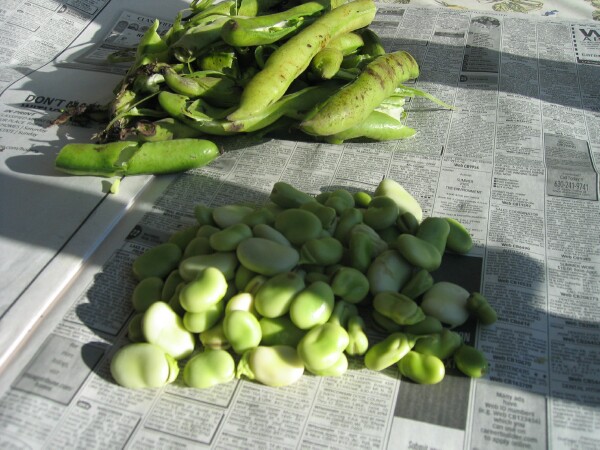
I cut up chunk of Pecorino Toscano, olive oil cured sheep's milk cheese from Tuscany, I picked up at The Cheese Stands Alone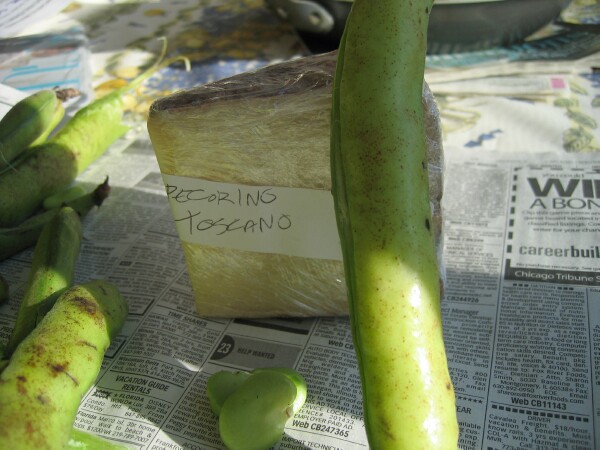
blanched the fava's for 2-minutes, shocked in ice water, dressed with olive oil, sea salt, fresh cracked pepper and lemon juice.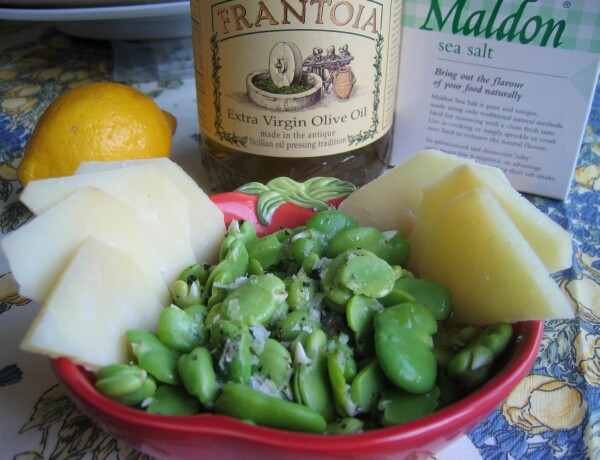
Along with the fava beans we had a wonderful, though budget killing, dinner of Soft Shell crab and a small piece of Copper River Sockeye Salmon from Dirk's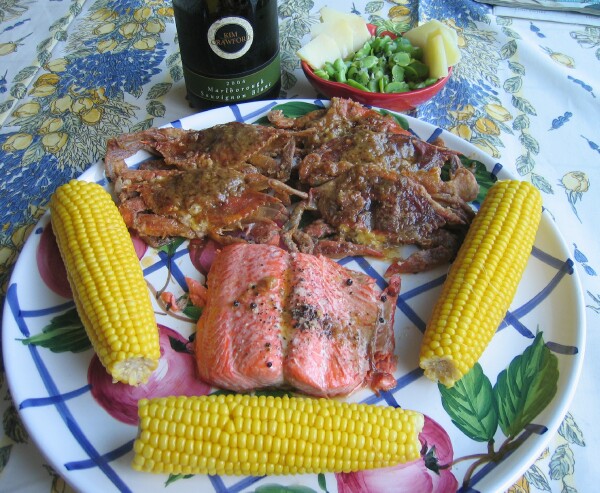
Thanks again for the idea, though next time I'm going to try to get you to shuck and peel the favas for me.
[Edit] I meant to note Andy's Fruit Ranch had fresh Green Almonds in stock yesterday.
Enjoy,
Gary
Andy's Fruit Ranch (fresh fava's)
4733 N Kedzie
Chicago, IL 60625
Dirk's Fish
2070 N. Clybourn Ave
Chicago, IL. 60614
773-404-3475
-
-
Post #13 - May 25th, 2005, 8:09 amGary:
That's certainly a fine looking plate of seafood there... Nice choices of olive oil and cheese to go with the "baccelli" too...
Thanks again for the idea, though next time I'm going to try to get you to shuck and peel the favas for me.
They are a pain, but lots of wine makes the work (seem to) go more quickly...
By the way, Lucantonius is available to do such work at a reasonable (non-union) hourly rate.

AAlle Nerven exzitiert von dem gewürzten Wein -- Anwandlung von Todesahndungen -- Doppeltgänger --
- aus dem Tagebuch E.T.A. Hoffmanns, 6. Januar 1804.
________
Na sir is na seachain an cath.
-
-
Post #14 - May 25th, 2005, 3:37 pmAntonius wrote:By the way, Lucantonius is available to do such work at a reasonable (non-union) hourly rate.
Antonious,
He's hired, do I contact Lucantonius directly or through you as his agent.
I'd love to know where you got that wonderful looking hunk-o-prosciutto. Talk about luxury, your very own prosciutto. (I'm trying to resist asking how you sliced the prosciutto. )
)
Enjoy,
Gary
-
-
Post #15 - November 2nd, 2007, 2:01 pmI know this will seem an incredibly naive question to the fava aficionados out there, but I have to ask. When they're in season I sometimes buy a big bag of fava beans at Caputo's market. I (I'm not sure of the terminology) shuck)?) all of the beans out of the pods. My question is, how do I know whether I should be going further and pulling the beans apart to reveal the tender, bright green interiors? Should I boil them all, large and small? Shoiuld I eat the small tender ones un(?)shucked, and for the larger beans, pry the tender, bright green interiors out?
A big bag of fava beans in the pod yields a pretty small appetizer of small green bean interiors, which brings me to seek some guidance on this topic.
I remember being, at certain times of the year, at homes in Chilean households where squeezing the bean interiors out of the shells was an hour-long, pre-Sunday-lunch communal activity. On the other hand, I remember seeing great quantities of pod-shucked, but not bean-pealed, fava beans on lunchtime buffets around town. I don't know if I'm making myself clear. I'm just asking, what part are you supposed to eat, and what are you supposed to discard?Last edited by Katie on April 21st, 2015, 12:17 pm, edited 1 time in total."Your swimming suit matches your eyes, you hold your nose before diving, loving you has made me bananas!"
-
-
Post #16 - November 2nd, 2007, 2:06 pmI think it depends on the size/maturity of the beans. Generally I remove both the outer, large pod and the smaller skin enclosing each bean (and I boil the beans for about 1 minute, then shock them in ice water, before removing the smaller skin from each bean).
If the beans are smaller, the skins can sometimes be left on.
-
-
Post #17 - November 2nd, 2007, 2:55 pmI also remove the little germ on the bean itself.
-
-
Post #18 - April 13th, 2009, 1:01 pmDigging up this old post to ask about sources for fresh favas.
Any sightings yet?
Been wanting to make this Fava Bean Cassoulet since.. uh.. the last time favas were in season.
http://www.chow.com/recipes/12420
-
-
Post #19 - April 13th, 2009, 2:35 pmHvae not been there yet myself this season but I've always found H-Mart to be a reliable early source. Perhaps one could call?Gypsy Boy
"I am not a glutton--I am an explorer of food." (Erma Bombeck)
-
-
Post #20 - April 13th, 2009, 9:52 pmThe only place I've seen them so far (and I bought some) were at Garden Fresh Market in Mundelein."Your swimming suit matches your eyes, you hold your nose before diving, loving you has made me bananas!"
-
-
Post #21 - April 19th, 2009, 9:53 pmFound some at Andy's Fruit Ranch. They also had lots of green almonds.
http://www.andysfruitranch.com
-
-
Post #22 - April 19th, 2009, 10:03 pmGot some at HarvestTime last week - they made a delightful puree per the Saveur formula: blanch, peel, warm in olive oil, puree and salt. Eaten on oiled toasted shapiro's rye, alongside a marinated skirt steak, and a baked potato. Nom.
-
-
Post #23 - June 25th, 2009, 8:25 pmLocal favas have finally arrived! Nichols had them today at Daley Plaza:
 ...defended from strong temptations to social ambition by a still stronger taste for tripe and onions." Screwtape in The Screwtape Letters by CS Lewis
...defended from strong temptations to social ambition by a still stronger taste for tripe and onions." Screwtape in The Screwtape Letters by CS Lewis
Fuckerberg on Food
-
-
Post #24 - June 26th, 2009, 5:04 amI can't vouch for the fact that they're still there, but I can say that they were at H-Mart at least three or four weeks ago.Gypsy Boy
"I am not a glutton--I am an explorer of food." (Erma Bombeck)
-
-
Post #25 - June 26th, 2009, 5:11 amGypsy Boy wrote:I can't vouch for the fact that they're still there, but I can say that they were at H-Mart at least three or four weeks ago.
yes, imported favas have been around for a couple of months now. Locals are way better than imported, imo... if you blanch them as soon as you get them home.
The combination of fresh favas and boiled egg is a classic I first tried in Spain. It's also popular, from what I understand, in some Arabic countries. In the dish above, everything was blanched or steamed, then tossed with good olive oil, a touch of fesh herbs, salt and pepper. The flavors and textures of the eggs with the favas really work beautifully together. Not sure I needed the carrots, but they didn't interfere too badly....defended from strong temptations to social ambition by a still stronger taste for tripe and onions." Screwtape in The Screwtape Letters by CS Lewis
Fuckerberg on Food
-
-
Post #26 - June 26th, 2009, 7:12 amNot just local favas, but use local romano cheese.
(*BTW, I whipped out that romano reference using our newly functioning search engine Michael's installed at the Local Beet. Come take a gander through our archives.)Think Yiddish, Dress British - Advice of Evil Ronnie to me.
-
-
Post #27 - June 26th, 2009, 9:32 amKennyz wrote:It's also popular, from what I understand, in some Arabic countries.
It certainly is. I think you will find a riff on fuul (Arabic for fava beans) in just about every country in the Middle East, North Africa and even East Africa. In Egypt, fuul is a staple, eaten every day, and said to make men strong and women handsome.
Typically, canned or dried beans are used. The Egyptian fuul preparation involves stewing the beans for hours until they are mushy, and then serving them with garnishes of your choice. My favorite is fuul Iskandirani ("Alexandrian favas") which is dressed with chopped onion, tomato, an herb of your choice (parsely, coriander, and less common but most delicious, dill), olive oil, lemon juice, and maybe a dashing of mixed spices (garam masala would work well). The shami ("Levantine") preparation involves whole beans that are almost al dente, dressed in olive oil with tons of parsely tomatos, and hot green peppers. I prefer Egyptian.
Another recipe that comes to mind, distinctly Palestinian and rather obscure but very delicious, is fuul bi laban, a lamb stew of sorts that also includes whole favas. This would probably be the best way to use fresh favas rather than canned or dried ones in an Arabic recipe. To make it, basically brown stewing lamb in olive oil. Remove, add onion and carmelize a bit, throw in some spices (allspice, cumin, black pepper) and deglaze with water. Add the lamb back in and stew until tender, maybe 2 hours, skimming foam as you go along. Finally, when the lamb is done, add a few cups of yogurt with a tablespoon or so of corn starch dissolved in a little water to make a yogurt broth. Throw in some fresh favas and let cook for a few minutes and voila - fuul bi laban - "Favas in yogurt." Serve over rice (it should be soupy) or with toasted Arabic bread on the side.
If I wasn't living in a crappy Brooklyn studio with no ventilation right now I would totally make this dish this weekend. No matter, I will wait until August when I get back to proper living in the Chi.
Best,
M"By the fig, the olive..." Surat Al-Teen, Mecca 95:1"
-
-
Post #28 - June 26th, 2009, 9:51 amM,
Thanks for the background on what sound like delicious preparations. To clairify, the "It" in the part of my post you quoted above actually referred to the combination of favas and boiled eggs - not just to favas themselves, which I know are a big part of Middle Eastern cuisine. Do you know of any dishes that feature that fava/ egg combo?
K...defended from strong temptations to social ambition by a still stronger taste for tripe and onions." Screwtape in The Screwtape Letters by CS Lewis
Fuckerberg on Food
-
-
Post #29 - June 26th, 2009, 10:00 amI noticed that after I posted....maybe this "lawyer" thing is not going to work out so well for me after all

Anyways, to answer your question - yes. Basically, the stewed Egyptian fuul I described is often topped with boiled, scrambled or over-easy eggs. The last being my fave prep because the yolk breaks and enriches the beans underneath. I think a poached egg would work great also. Often, the fuul and egg combo is also topped with basturma, the fenugreek-heavy cured beef that people either seem to love or hate. Whatever the case, fuul is awesome because it can be eaten plain, or used as a vehicle for whatever you can come up with. And it's healthy as a mofo.
I have fond recollections of starting every day in Cairo with fuul, no exceptions. Naguib Mahfouz, the Cairene Nobel laureate, however, used to complain in his characters that with a daily diet of fuul even donkeys ate better. I humbly disagree."By the fig, the olive..." Surat Al-Teen, Mecca 95:1"
-
-
Post #30 - June 26th, 2009, 11:19 amHabibi wrote:If I wasn't living in a crappy Brooklyn studio with no ventilation right now I would totally make this dish this weekend. No matter, I will wait until August when I get back to proper living in the Chi.
Very sadly, my one trip to Cairo--though longish--left little time to eat "right." And so I spent two weeks there on official government business and had fuul exactly never. So: let me know when you're making it, I'm ready to help you chow down! Gypsy Boy
Gypsy Boy
"I am not a glutton--I am an explorer of food." (Erma Bombeck)

